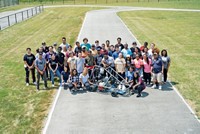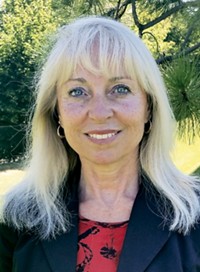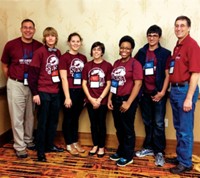Advertisement
Grab your lab coat. Let's get started
Welcome!
Welcome!
Create an account below to get 6 C&EN articles per month, receive newsletters and more - all free.
It seems this is your first time logging in online. Please enter the following information to continue.
As an ACS member you automatically get access to this site. All we need is few more details to create your reading experience.
Not you? Sign in with a different account.
Not you? Sign in with a different account.
ERROR 1
ERROR 1
ERROR 2
ERROR 2
ERROR 2
ERROR 2
ERROR 2
Password and Confirm password must match.
If you have an ACS member number, please enter it here so we can link this account to your membership. (optional)
ERROR 2
ACS values your privacy. By submitting your information, you are gaining access to C&EN and subscribing to our weekly newsletter. We use the information you provide to make your reading experience better, and we will never sell your data to third party members.
Careers
Science Bound: A Diversity Program That Works
by Tom Barton, ACS Immediate Past-President
October 19, 2015
| A version of this story appeared in
Volume 93, Issue 41
If you are like me (no, no, wait, don’t go away), you have periodically wearied at seemingly incessant diversity events, which appear to have neither substance nor hint of lasting value. Yes, I speak of workshops, symposia, lectures, celebrations, diversity days and lunches, and even diversity calendars (I kid you not!). During some of these activities, I have quietly observed to myself that some of the people who get involved—all regally cloaked with political correctness—don’t seem to have a clue what the real value of diversity can be or how to achieve it. Thus, I am truly pleased to tell you about a remarkable diversity program at Iowa State University (ISU) that is working very well and yielding exciting, quantifiable results. It’s a program called Science Bound.
So what exactly is Science Bound? Going into its 25th year, Science Bound is a university-led, four-way partnership among businesses, three school districts, students and their parents, and ISU. It is one of few programs in the state of Iowa designed exclusively for increasing the number of ethnically diverse students motivated, prepared, and empowered to earn degrees in science, technology, engineering, and math (STEM) fields.
For a student, the Science Bound experience begins when a participating middle school teacher identifies a seventh-grade student with the potential to be successful in a STEM field. The teacher explains Science Bound and encourages the student to apply. Next, the program staff meet with the student and her or his parents, and if they are in agreement, a contract is signed by all, clearly stating the requirements that the student must meet over the next five years. Successful conclusion of the program leads to a four-year, full-tuition scholarship if the student attends ISU and majors in a technology-related field.
After Completion Of The Five-Year Science Bound Program, Each Participant Has Done The Following:
◾ Completed college preparation courses
◾ Earned a minimum grade point average of 3.0 each semester
◾ Participated in 75% or more of Science Bound activities
◾ Engaged in a minimum of 140 hours of out-of-school, hands-on science experiments and activities including design, conduct, and presentation of a science fair project
◾ Participated in 15 different STEM laboratory activities on the ISU campus
◾ Participated in a 40-hour career exploration program each summer
The head of the Gomez household is Victor, a Mexican American who moved from California to Iowa with his wife, Selena, and their four children. Victor is a machinist when he can find work, and Selena works as a housekeeper at local motels. As the children progressed in school, the chance for any of them to attend college seemed remote. However, before entering the eighth grade, Rebecca, the oldest, was selected to participate in Science Bound, and her parents gratefully and enthusiastically supported this path. The program provided Rebecca with the support needed to excel in the classroom and prepare for college and a STEM major.
Thanks to Science Bound, the three oldest Gomez siblings have received four-year tuition scholarships and are currently enrolled at ISU—two pursuing engineering degrees, and one pursuing a biology degree. The youngest, Thomas, has another year of high school before he can follow the same path.
Another student who benefited from this program is Alma Marquez, a graduate of East High School in Des Moines, who participated in Science Bound in grades eight to 12. She attended weekly meetings, made regular visits to Science Bound events at ISU, and maintained a high grade-point average. At ISU, she found her fit in chemical engineering, graduated with a B.S. degree this May, and now works at Cargill. When asked about the role that the program played in her life, she says, “I had thought about college, but I didn’t see how I could make that dream a reality. I don’t think I’d be here if it weren’t for Science Bound, and I definitely don’t think I would be a chemical engineer. Science Bound offers more than a scholarship. They are a family that will help you find a successful STEM future.”
Science Bound doesn’t disappear from the lives of students after high school. Not only do staff often partner with parents to navigate the process of going to college, including applications, financial aid, and housing and meal plans, but Science Bound also offers a home base, a safe haven on campus through its counseling offices, conference rooms, and computer-equipped study rooms, which just happen to be located 60 feet from my office.
It is so nice to see a program in such a vital area that is working so well: Of the current 440 participants, 54% are Latino, 32% African American, 13% multiracial, and 1% Native American; 97% of Science Bound graduates go on to enroll in postsecondary schools; and during the 2014–15 academic year, 116 Science Bound students were enrolled at ISU. The numbers speak for themselves: Science Bound is a diversity program that is really working.
To learn more about this great program, go to www.sciencebound.iastate.edu.
Views expressed on this page are those of the author and not necessarily those of ACS.






Join the conversation
Contact the reporter
Submit a Letter to the Editor for publication
Engage with us on Twitter